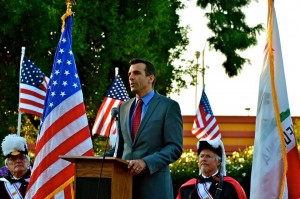I Prefer Solutions to Scare Tactics
I’ve dedicated much of my career to confronting crime, and the fears that surround it. As a criminal prosecutor in San José, I spent many hours eliciting courtroom testimony from trembling victims, who mustered the courage to testify against their assailants.
Navigating this sea of fears poses a test for political leaders, particularly in an election season. Some respond with scare tactics. I prefer solutions.
Responsible solutions require money to pay for them.
I’ve made reducing crime my top priority, and have crafted a comprehensive plan to do so, beginning with hiring more police officers. More importantly, I’ve put that plan into action by gaining San Jose City Council approval of a strategy to identify over $30 million in pension reform savings to accelerate police hiring and improve officer retention. That has enabled SJPD to add a third police academy this year, and to restore police salaries.
I’ve also led more innovative and cost-effective approaches to reducing crime. Three weeks ago, for example, the city council approved my initiative to create a voluntary registry for private video cameras, an on-line tool that has facilitated hundreds of arrests in Philadelphia.
In this mayoral campaign, others have chosen scare tactics. Police union bosses seeking to elect Dave Cortese have sought to manipulate fears, spending $600,000 on mailers to falsely assert, for example, that I voted to eliminate SJPD’s burglary investigations unit — a unit that still exists, by the way — or that property crimes are skyrocketing (despite SJPD’s own crime statistics, which reveal a 16 percent drop in the last two years, and a lower violent crime rate than any large city in the United States.
The police union wants to obscure the fact that Cortese’s only “plan” consists of restoring police staffing by again hiking benefits and pay, without identifying any way to pay for it. This should sound familiar; during Cortese’s tenure on the pension board and city council, he voted seven times to expand costly retirement benefits for employees, without paying for any of them. We still struggle under the burden of Cortese & Company’s last spending spree: some $3 billion of unfunded retirement debt. Skyrocketing pension costs forced layoffs, hiring freezes, and pay reductions that shriveled SJPD by 323 officers, until the voters enacted pension reform in 2012.
Ignoring repeated reports of police union bosses sabotaging SJPD recruiting efforts, Cortese instead attributes the depletion of our officers to what he recently called their “underpensioned” plight. SJPD officers retire today, on average, in their early 50s with a $104,000 pension that grows to over $200,000 annually by their 70s.
 There’s a better way. As I’ve described in my book, at www.samliccardo.com, we don’t need to spend more to make San José safer; we need to spend smarter. We can use our police officers’ time more effectively on neighborhood patrols by expanding our civilian Community Service Officer program to take on less urgent tasks like report-writing and evidence-gathering, and by using data analytics to target emerging hot spots of crime. We can expand after-school programs for youth, and create hundreds of summer jobs for teens, both proven approaches that get to kids before gangs do. Most importantly, I’ve actually identified a way to pay for these programs.
There’s a better way. As I’ve described in my book, at www.samliccardo.com, we don’t need to spend more to make San José safer; we need to spend smarter. We can use our police officers’ time more effectively on neighborhood patrols by expanding our civilian Community Service Officer program to take on less urgent tasks like report-writing and evidence-gathering, and by using data analytics to target emerging hot spots of crime. We can expand after-school programs for youth, and create hundreds of summer jobs for teens, both proven approaches that get to kids before gangs do. Most importantly, I’ve actually identified a way to pay for these programs.
Four San José Mayors — Susan Hammer, Tom McEnery, Ron James, and Chuck Reed — and two District Attorneys agree that my leadership will make San José safer. They understand that making San José safer requires not simply paying police to retire, but paying them to work — and still having enough dollars to keep libraries open, expand school crossing guard programs, and keep kids out of gangs. They prefer solutions over scare tactics. So will our voters.
Sam Liccardo, who represents District 3 on the San Jose City Council, is a candidate for mayor of San Jose. He wrote this for this newspaper.
